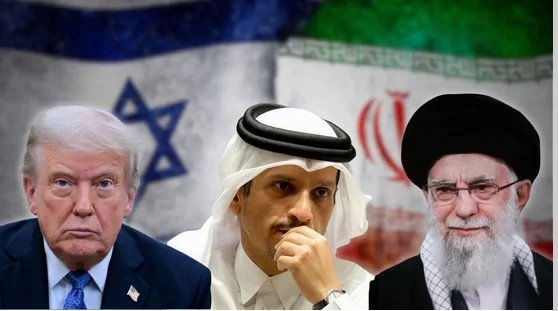
In a significant diplomatic development, the Trump administration reportedly played a crucial role in facilitating a ceasefire agreement between Iran and Israel, with Qatar acting as the mediator. According to various American media sources, this agreement marks a notable step towards easing tensions in the volatile Middle East region, which has long been marred by conflicts and proxy wars.
Background to the Ceasefire
The ceasefire followed a period of heightened hostilities that culminated in Iranian missile strikes on June 23, 2025, targeting the U.S. Al-Udeid Air Base in Qatar. These strikes, while significant, reportedly caused no casualties or major damage, as Iran had forewarned the base operators before the attacks. This unusual act of prior notification signaled a complex strategic calculus behind Iran’s military move — a demonstration of power coupled with a desire to avoid escalation into full-scale war.
Following the strikes, diplomatic channels rapidly opened, leading to an unprecedented announcement on June 24 that Iran and Israel had agreed to halt all military actions. The deal reportedly stipulated that Iran would cease hostilities immediately, with Israel agreeing to stand down within 12 hours thereafter. This sequence highlights the delicate balance and mutual wariness that defines relations between the two regional adversaries.
Qatar’s Role as a Mediator
Central to this diplomatic success was Qatar, whose role as an intermediary proved indispensable. Qatar’s Foreign Minister, Sheikh Mohammed bin Abdulrahman Al Thani, emphasized his country’s commitment to peaceful resolutions and diplomatic engagement. Qatar has a history of acting as a neutral ground for sensitive negotiations, having previously facilitated dialogues between Iran and the United States during times of heightened tensions.
The Gulf nation’s ability to maintain working relationships with diverse actors — including Iran, the U.S., and Israel — positioned it uniquely to broker this delicate agreement. Doha’s efforts underscore how smaller regional powers can exert outsized influence in conflict resolution by serving as trusted intermediaries. This ceasefire is not just a victory for the Trump administration’s foreign policy approach but also a testament to Qatar’s growing diplomatic clout.
Trump Administration’s Diplomatic Strategy
The Trump administration’s involvement in this ceasefire is notable given its historically hardline stance toward Iran. Throughout Trump’s presidency, the U.S. adopted a “maximum pressure” policy aimed at curbing Iran’s nuclear ambitions and regional influence through economic sanctions and military deterrence.
Yet, this latest development reveals a nuanced layer to the administration’s approach: while publicly pursuing tough sanctions and isolation, behind the scenes it engaged in diplomatic efforts to prevent wider conflict. The Trump administration’s willingness to work through third-party countries like Qatar demonstrates an understanding that direct talks with Iran were politically sensitive and complex, necessitating alternative channels.
This ceasefire can be interpreted as a pragmatic maneuver to de-escalate tensions and buy time for longer-term negotiations on Iran’s nuclear program and regional behavior. Analysts suggest that it also served to protect U.S. interests by preventing a broader war that could destabilize U.S. allies and jeopardize military assets in the Gulf.
Regional and Global Implications
The ceasefire’s immediate effect was the cessation of military actions, providing a much-needed respite for a region plagued by decades of conflict. For Israel, the agreement reduced the imminent threat of Iranian-backed attacks. For Iran, it avoided the risk of a direct confrontation with Israel and its powerful allies.
Beyond the bilateral dynamic, this ceasefire could signal a potential shift toward more diplomatic engagement in the Middle East. It reflects how even deeply entrenched hostilities can be temporarily set aside when pragmatic interests align. However, the sustainability of this truce remains uncertain. Both sides have historically shown reluctance to fully commit to lasting peace, and the underlying geopolitical rivalries continue to simmer beneath the surface.
On a global scale, the ceasefire sends a message about the role of unconventional diplomacy — using third-party states and back channels to navigate conflict. It may also influence future U.S. policy in the region, balancing pressure tactics with strategic dialogue.
Challenges Ahead
Despite the optimism surrounding the ceasefire, several challenges remain. The deep mistrust between Iran and Israel, combined with competing interests among regional powers, makes any lasting peace fragile. Additionally, domestic political pressures on all sides could undermine adherence to the ceasefire terms.
The international community will be watching closely to see if this agreement marks the beginning of a new chapter in Middle Eastern diplomacy or remains a temporary pause in an ongoing cycle of conflict.
Conclusion
The Trump administration’s reported success in securing a ceasefire between Iran and Israel through Qatar’s mediation represents a significant diplomatic achievement. It highlights the complex interplay of military deterrence, strategic signaling, and backdoor diplomacy that shapes modern international relations in the Middle East. While challenges remain, this ceasefire provides a hopeful example of how dialogue and intermediaries can pave the way toward peace in one of the world’s most troubled regions.
Reference: ٹرمپ انتظامیہ نے ایران کو جنگ بندی کیلئے قطر کے ذریعے راضی کیا: امریکی میڈیا


